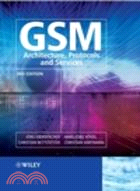| FindBook |
|
有 1 項符合
jorg eberspacher的圖書 |
 |
$ 1600 | GSM: ARCHITECTURE, PROTOCLS AND SERVICES 3/E
作者:JORG EBERSPACHER 出版社:全華經銷 出版日期:2009-02-24 規格:25*17.5cm  看圖書介紹 看圖書介紹
|
|
|
- 圖書簡介
With around 3 billion subscribers, GSM is the world's most commonly used technology for wireless communication. Providing an overview of the innovations that have fuelled this phenomena, GSM: Architecture, Protocols and Services, Third Edition offers a clear introduction to the field of cellular systems. Special emphasis is placed on system architecture and protocol aspects, and topics range from addressing concepts through mobility management to network management.
This third edition contains around 25% new and reworked material and has been thoroughly updated to encompass recent advances and future trends. It serves as both an introductory textbook for graduate students as well as a reference resource for telecommunications engineers and researchers.
This edition:
Presents capacity enhancement methods like sectorization, the application of adaptive antennas for Spatial Filtering for Interference Reduction (SFIR) and Space Division Multiple Access (SDMA)
Provides a detailed introduction to GPRS, HSCSD, and EDGE for packet-switched services and higher data rates
Features updated coverage on the vastly expanded range of GSM services, including an examination of Multimedia Messaging Service (MMS)
Adopts a highly graphical approach with numerous illustrations - 目次
Preface.
1. Introduction.
1.1. The idea of unbounded communication.
1.2. The success of GSM.
1.3. Classification of mobile communication systems
1.4. Some history of statistics of GSM.
1.5. Overview of the book.
2. The mobile radio channel and the cellular principle.
2.1. Characteristics of the mobile radio channel.
2.2. Separation of directions and duplex transmission.
2.3. Multiple access.
2.4. Cellular principle.
3. System architecture and addressing.
3.1. System architecture.
3.2. The SIM concept.
3.3. Addressing.
3.4. Registers and subscriber data.
3.5. Network interfaces and configurations.
4. Air interface - physical layer.
4.1. Logical channels.
4.2. Physical channels.
4.3. Synchronization.
4.4. Mapping of logical onto physical channels.
4.5. Radio subsystem link control.
4.6. Channel coding, source coding and speech processing.
4.7. Source coding and speech processing.
4.8. Channel coding.
4.9. Power-up scenario.
5. Protocols.
5.1. Protocols architrecutre planes.
5.2. Protocol architecture of the user plane.
5.3. Protocol architecture of the signaling plane.
5.4. Signaling at the air interface (Um).
5.5. Signaling at the A and Abis interfaces.
5.6. Security-related network functions: authentication and encryption.
5.7. Signaling at the user interface.
6. Roaming an handover.
6.1. Mobile application part interfaces.
6.2. Location registration and location update.
6.3. Connection estalishment and termination.
6.4. Handover.
7. Services.
7.1. Classical GSM services.
7.2. Popular GSM services: SMS and MMS.
7.3. Overviwe of GSM services in Phase 2+.
7.4. Bearer and teleservices of GSM Phase 2+.
7.5. Supplementary services in GSM Phase 2+.
7.6. Service platforms.
7.7. Wireless application protocol.
8. Improved data services in GSM: GPRS, HSCSD and EDGE.
8.1. GPRS.
8.2. HSCSD.
8.3. EDGE.
9. Beyond GSM and MTS: 4G
Appendices.
A. Data communication and networking.
B. Aspects of network operation.
C. GSM Addresses.
D. List of Acronyms.
References.
Index.
|











